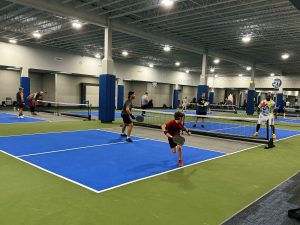Guest post written by Johnny Crosskey, SEO & Content Specialist, The Sports Facilities Companies.
People have already been exposed to wearables through a variety of fitness trackers and smart watches flooding the market in recent years. According to research from PricewaterhouseCoopers (PwC), 1/5th of all American adults currently own a wearable device. This presents a great opportunity for sports and event venues to integrate wearable technology with seamless adaption.
How It Works:
With wearable technology, guests receive either wristbands, badges, or buttons that contain near-field communication chips that allow the device to push data towards a central hub. Wristbands and badges for events use built-in sensors to transmit location data to central server. To transmit data from the wearable to the server, Bluetooth Low Energy (BLE) beacons are placed strategically throughout a venue. The BLE beacons capture small bits of data from wearables and transmit them via Wi-Fi to a server where the data processed for a variety of uses.
For example, when a wearable user performs activities, such as entering a venue, touching another wearable, or contacting a point-of-sale device, an action is triggered. This may include a purchase, an exchange of contact information, or a push notification for a discount on an apparel item.
Benefits:
The event attendee receives an easy experience. Wristbands received by athletes and their families can be used to make purchases at concession areas, enter restricted parts of facility, or exchange contact information with other attendees. For athletes, biometric information such as heart rate and oxygen intake can be tracked. Performance statistics can be tracked as well when combined with an app. These benefits allow for more detailed analysis of the connection between physical performance and conditioning.
As mentioned previously, wearable devices can also trigger notifications for upcoming events and discounts on food and apparel items when devices are connected to smartphone apps.
For event operators, wearables track attendee movement. Understanding how guests maneuver within your facility allows you see what areas are frequented most, what games and activities received the most attention, and where bottlenecks are developing. Information about the games and activities that attendees are frequenting most is particularly valuable as it can help tournament rights holders determine which teams to invite for future events and what activities resonate most with their audience. Understanding traffic flow within a facility can inform future layout strategies and reveal a need for better wayfinding. For example, if guests are gravitating to a central bathroom or concession stand, wearable data can detect it, and the event organizer can direct them to other options within the facility, potentially through an app. This can also be done with directing guests to alternate entrances and exits.
Additionally, understanding how guests interact with a facility can present revenue generation opportunities by placing sponsored branding, messaging, or deals in areas where people congregate most.
Barriers To Entry:
From the IT infrastructure to the BLE beacons to the wearables themselves, this technology represents a significant investment. Until the technology becomes more mainstream, it may be difficult for facility owners and operators to see the ROI from providing a completely frictionless experience for guests. Especially considering that youth sports event attendees aren’t largely asking for this experience, yet. As more facility projects begin integrating this technology and more case studies are developed, fans will demand it and we will see more wearable technology in sports venues.
In terms of the data generated from wearables, facility operators may not initially understand how to utilize this information. Once the technology becomes more common in venues, best practices will be established, and this information will help facilities become more operationally efficient.
Wearable Technology In Action:
There are several places in professional sports where wearable technology is making an impact. Manchester City, a soccer team in the English Premiere League, has teamed up with a company called Fantom to produce a wristband that lets fans receive detailed preview information leading up to matches, get live match updates, play interactive quizzes, and more. Much of these features can be accessed via the black touchscreen display in the center of the wristband. The smart wristband with NFC capabilities is also a season ticket that can be used to enter the stadium. Fans can purchase food and apparel with the band as well as detect and connect with fans in their area.






